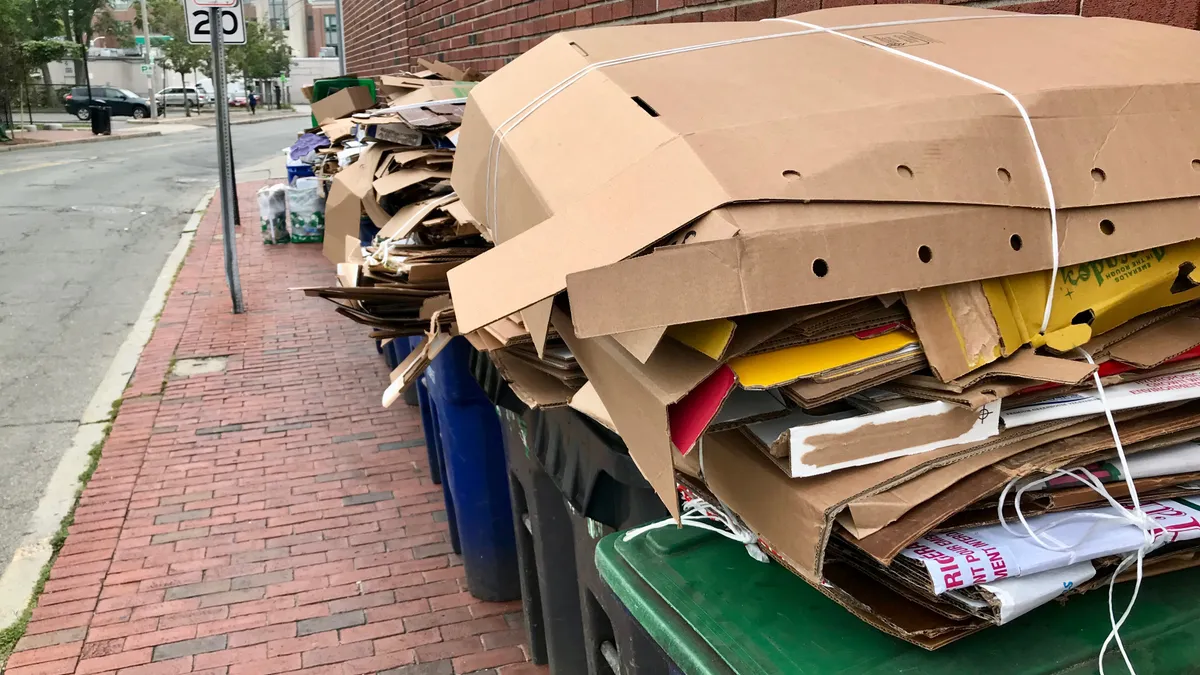Paper and plastic market experts at the Institute of Scrap Recycling industries' April convention highlighted positive trends keeping recovered paper demand high, but they warned of U.S. recycling infrastructure challenges that could affect future demand for post-consumer plastic resin.
Recycled cardboard and mixed paper prices and demand are increasing, paper market analysts said, in part because of e-commerce sales, demand from multiple Asian countries, and domestic mill upgrades that will allow more mixed paper inputs. Meanwhile, plastics market experts highlighted the challenge of collecting enough recycled plastic to meet future demand from big brands pledging to use more recycled content in their products.
Here are some highlights from discussions of these markets at ISRI’s annual convention:
Positive outlooks for OCC and mixed paper
In 2020, overall U.S. consumption of recovered fiber reached its highest level in 10 years, hitting 22.77 million tons, said Megan Workman, an editor and price reporter at Fastmarkets RISI, during a paper markets discussion. “That is a great sign for our market,” she said.
The global market for recovered paper, especially old corrugated cardboard (OCC), is on the rise as well, Workman said. India has emerged as a major importer of recovered fiber from the U.S., along with Indonesia, South Korea, Taiwan, Thailand, and Vietnam, she said.
Continued demand for cardboard boxes — and the OCC they’re made from — will likely keep demand and prices high throughout the year, Workman said. Overall demand for cardboard is expected to continue increasing slowly over the next four to five years, according to research from RISI senior economist Hannah Zhao, which Workman highlighted in her presentation.
Part of the uptick in demand and prices for cardboard comes from booming e-commerce sales. Another major price driver is China’s production of brown recycled pulp. OCC, mainly from the U.S., is its primary component, Workman said. China has banned imports of most grades of recovered fiber, but “they haven't banned or really set any specifications at all on this brown recycled pulp,” she said. Fastmarkets RISI introduced a new brown recycled pulp pricing in January to reflect this demand.
April prices for OCC averaged $88 during the second-to-last week of the month, which was up 24%, or $17, from that time in March, Workman said. The April price is up 77% from that same week in 2020, which itself was up 77% from that time in 2019, “So OCC’s pricing continues just to increase year over year,” Workman said.
Higher commodity prices have been a boon for waste and recycling haulers recovering from the COVID-19 pandemic, with companies like Waste Connections recently noting better-than-expected OCC prices had a role in improving quarterly revenues.
Mixed paper prices also are up significantly from 2018 and 2019, when prices were negative because of China's import bans. At that time, many MRFs reacted by disposing the paper or stockpiling it in warehouses while they looked for domestic markets, Workman said.
Today, more U.S. paper mills see value in mixed paper and have made upgrades to their facilities to use it in their products, she said. This is a relatively recent development that Workman predicts will continue to help drive demand, but she expects the trend to continue slowly because it takes time for mills to make these investments and slowly add mixed paper to their feedstock.
Export markets for mixed paper have also improved from their demand and pricing nosedives in 2018 and 2019, she added.
Plastics recycling infrastructure could affect future PCR demand
U.S. markets for recycled plastics face complex problems as recyclers, processors, resin producers and brand owners try to figure out the best ways to integrate post-consumer resin (PCR) into new products, speakers at a plastics panel said.
Brands pledges to use more post-consumer recycled plastics in their products, along with newly passed recycled content mandates in states such as California, will play a major role in driving demand for post-consumer resin, they agreed.
Yet the panelists also expressed concern over recyclers’ ability to meet that future demand with the country’s current recycling infrastructure. Each of the thousands of communities in the U.S. collects different types of materials, “so there's no consistency from one system versus the other. That's a significant issue,” said Steve Alexander, president of the Association of Plastic Recyclers. That lack of consistency creates confusion about what goes in the blue bin, leading to contamination, he said.
Alexander estimates recyclers will need to collect more than four times more plastic by 2025 than they are currently collecting, but “asking the current infrastructure to generate the potential feedstock for recycling that the brands have indicated they want is like asking a 1978 Chevrolet Chevette to meet current California emissions standards.”
Panelists stressed the importance of tapping into commercial recycling streams, which tend to be cleaner than residential recycling streams and can deliver a high volume of plastics for recycling. Only a very small fragment of plastic material within a household is even suitable for the curbside stream, said Nina Butler, CEO of Stina, formerly known as More Recycling. Thus, working with brand owners to create more recyclable packaging is another important step, Butler and Alexander said.
Eadaoin Quinn, director of business development and procurement at PCR manufacturer EFS Plastics, said her company’s challenge is finding processors who can sell her company the high-quality feedstock they need to create resins that meet brand owners' standards, especially for food-grade resins.
Plastics found in curbside recycling bins are not always the best source for this material because of high contamination levels. She isn’t convinced that educating residents about what goes in the bin will be enough to pull in dramatically more suitable feedstocks. Instead, Quinn said, the industry must promote other market drivers, such as minimum recycled content legislation.
“I have really disliked the question of what else can we do to educate people, because it's not their fault,” she said.























